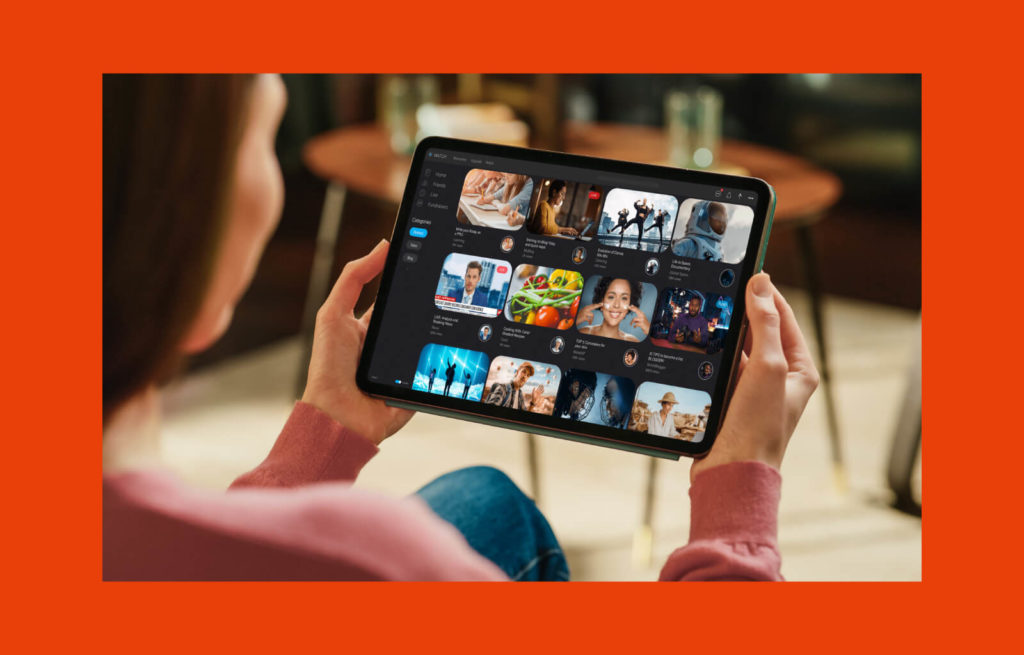The ultimate guide to OTT content monetisation
Whether you are a content creator looking for new options or a business looking for new opportunities in the booming media and entertainment industry, it is important to keep up to date. Keeping your finger on the pulse is essential, especially when it comes to discovering innovative ways to generate additional revenue from existing assets. It is crucial to explore the most profitable over-the-top (OTT) content monetisation models to ensure you stay ahead of the curve. Stay tuned for insights that could transform your strategy and significantly enhance your financial performance.
What is content monetisation?
OTT content monetisation encompasses various tactics and strategies implemented to secure a substantial return on the effort and resources invested in content creation and distribution.
This process involves several methodologies, such as subscription-based models, advertising, pay-per-view, and sponsored content, all aimed at optimising the financial benefits of digital content. By effectively monetising content, creators and businesses not only enhance their immediate financial health but also invest in the long-term viability of their offerings. Thus, content monetisation is essential, as it ensures creators are compensated for their efforts while also providing a foundation for the continuous growth and development of their enterprises.
How to start monetising your content with OTT solutions
When you are ready to elevate your content monetisation strategy beyond basic platforms like YouTube, embracing OTT solutions can significantly enhance your revenue streams. Here is how to start monetising your content with advanced OTT strategies.
Assess your content and audience
The first step in leveraging OTT for content monetisation is a thorough assessment of your existing content and your audience. Identify the types of content that generate the most engagement and analyse your audience’s preferences and demographics. This understanding will help you tailor your OTT offerings to match audience demand, ensuring a higher conversion rate.
Choose the right OTT platform
Selecting the appropriate OTT platform is crucial. Consider platforms that offer robust infrastructure, favourable revenue-sharing terms, and the ability to reach your target audience effectively. Some platforms might cater specifically to niche markets or offer enhanced features for certain types of content, such as high-definition video or live streaming capabilities.
Develop a monetisation strategy
Your monetisation strategy should be multifaceted:
• Subscription models: Offer tiered subscription options to cater to different viewer preferences and budget levels. This can include everything from a basic access level to premium packages with exclusive content.
• Advertising: Integrate targeted advertisements into your content. Opt for platforms that offer sophisticated ad management tools that allow for better targeting and revenue tracking.
• Pay-per-view: For exclusive events or high-demand content, consider a pay-per-view model. This can be particularly effective for live events, special episodes, or early releases.
• Sponsorships and partnerships: Collaborate with brands that align with your content’s theme or your audience’s interests. These partnerships can include sponsored episodes or branded content integrations.
Prepare your content
Preparing your content for OTT involves ensuring high-quality production values and possibly adapting your content format to suit the platform and your audience’s viewing habits. This might include editing your videos to fit different screen sizes, enhancing sound quality, or adding subtitles and other accessibility features.
Implement analytics tools
To effectively monetise your OTT content, you need robust analytics tools. These tools will help you track viewer engagement, analyse revenue streams, and adjust your strategies based on data-driven insights. Understanding which content performs best and which monetisation strategies are most effective will allow you to continually refine your approach.
Promote your OTT content
Promotion is key to successful monetisation. Use social media, email marketing, influencer collaborations, and other marketing strategies to drive traffic to your OTT content. Effective promotion not only increases viewership but also enhances subscription rates and advertising revenue.
Continuous improvement and scaling
As you gather more data on your audience’s preferences and viewing behaviour, continuously refine and expand your content offerings. Explore new content types, expand into new markets, or enhance your OTT platform’s features to better serve your audience and maximise revenue.
Types of OTT content that can generate financial profit
By using OTT platforms as your main distribution channel, you will encounter virtually no restrictions on the type of content you can publish, as long as it complies with content classification standards such as age appropriateness. This unrestricted environment offers a distinct advantage over free, open-access platforms, where creative freedom is often restricted by strict rules.
The main challenge in creating OTT content can be navigating sensitive material regulations, but many platforms provide advanced advertising options and tools to effectively manage these concerns. Ensuring compliance and effective use of these tools is critical and can usually be improved by working with an OTT service provider.
Understanding core monetisation models
Without further ado, let’s dive directly into the core topic we have been leading up to. The environment of available OTT solutions is in a state of continual evolution, driven by relentless technological advancements.
For OTT content providers, staying abreast of these changes and maintaining a competitive edge can be daunting without a robust and well-structured monetisation model. Here are the key models you should consider when planning your next strategic investment.
Free Ad-Supported Streaming TV (FAST)
This model is rapidly gaining traction in the OTT space. FAST channels provide viewers with a linear TV experience, but over the internet and without any subscription fees. Instead, revenue is generated through advertisements interspersed within the content, similar to traditional broadcast television. This model appeals to users who prefer the lean-back experience of scheduled programming but desire the flexibility and variety offered by digital platforms.
FAST channels often curate content around specific themes or interests, offering a tailored viewing experience that traditional TV cannot match. For content providers, FAST represents an opportunity to capture audience segments that are more comfortable with the conventional TV format while also taking advantage of digital advertising’s targeting capabilities. This model can be particularly effective when combined with other revenue strategies, providing a comprehensive monetisation framework that maximises both reach and revenue potential.
Advertising-Based Video on Demand (AVOD)
Advertising-Based Video on Demand (AVOD) is a model where viewers access video content for free, but in return, they watch advertisements before and during the video. This model is comparable to traditional television, where the cost of programming is covered by ad revenue rather than direct payments from viewers. The essence of AVOD is that it leverages the watch time of viewers to generate revenue from advertisers, making high-quality content accessible without subscription fees.
According to Digital TV Research, the global reach of AVOD is projected to increase substantially, with revenue expected to hit $91 billion by 2028. This growth highlights the model’s effectiveness in attracting a broad audience and providing a viable revenue stream for content creators and distributors.
Subscription Video on Demand (SVOD)
In contrast to Advertising-Based Video on Demand (AVOD), Subscription Video on Demand (SVOD) platforms operate on a different model. With SVOD, users pay a recurring fee—usually monthly or annually—in exchange for access to a library of premium content. This model fosters a direct financial relationship between the company and the consumer, providing a range of exclusive benefits and a stable revenue stream for the platform.
One of the primary advantages of SVOD is the consistent revenue stream it provides. Unlike the fluctuating income from ads in the AVOD model, subscription fees offer predictable financial returns, allowing for better financial planning and investment in new content.
Transactional Video on Demand (TVOD)
Transactional Video on Demand (TVOD) offers a flexible approach to consuming video content. Unlike AVOD and SVOD, TVOD operates on a pay-per-view basis. This model allows viewers to choose exactly what they want to watch and pay only for the selected content, providing a more tailored viewing experience.
The main benefit is that TVOD provides viewers with the freedom to select and pay for only the content they are interested in. This model eliminates the need to commit to a subscription or endure advertisements.
For content creators and distributors, TVOD can generate significant revenue from new releases and exclusive content that attracts eager viewers willing to pay a premium for early access.
Hybrid models
Hybrid models are emerging as a highly effective strategy to capture diverse audience segments and maximise revenue streams. They leverage the strengths of different monetisation strategies, offering a blend of Subscription Video on Demand (SVOD), Advertising Video on Demand (AVOD), Free Ad-Supported Streaming TV (FAST), and Transactional Video on Demand (TVOD).
Hybrid OTT models integrate multiple monetisation methods to create a more flexible and appealing offering for both viewers and content providers. The most successful platforms are increasingly adopting a combination of SVOD and AVOD, recognising that this dual approach can cater to a broader audience. While SVOD provides an ad-free, premium experience for subscribers willing to pay a monthly fee, AVOD offers free access supported by advertisements, attracting viewers who are more price-sensitive.
The last words
By adopting a robust and multifaceted monetisation strategy, you can effectively tap into diverse revenue streams and ensure sustainable growth. The key lies in understanding your audience, selecting the right OTT platform, and employing a mix of monetisation models such as FAST, AVOD, SVOD, TVOD, and hybrid approaches.
By staying informed about industry trends and technological advancements, and by continuously adapting your approach, you can maintain a competitive edge in the OTT space. As the digital media industry continues to grow, the opportunities for monetising your content will only expand, offering new ways to enhance your financial performance and achieve sustained success.
Take the next step
Ready to transform your content monetisation strategy and unlock new revenue streams? Do not wait any longer. Start exploring advanced OTT solutions tailored to your unique needs today. Whether you are a content creator looking to maximise your efforts or a business seeking new opportunities, the right monetisation strategy can make all the difference.
Contact us via the form below and discover how our expertise can help you stay ahead of the curve and achieve your financial goals. Let’s turn your content into a thriving business.
About the author
Get in touch





